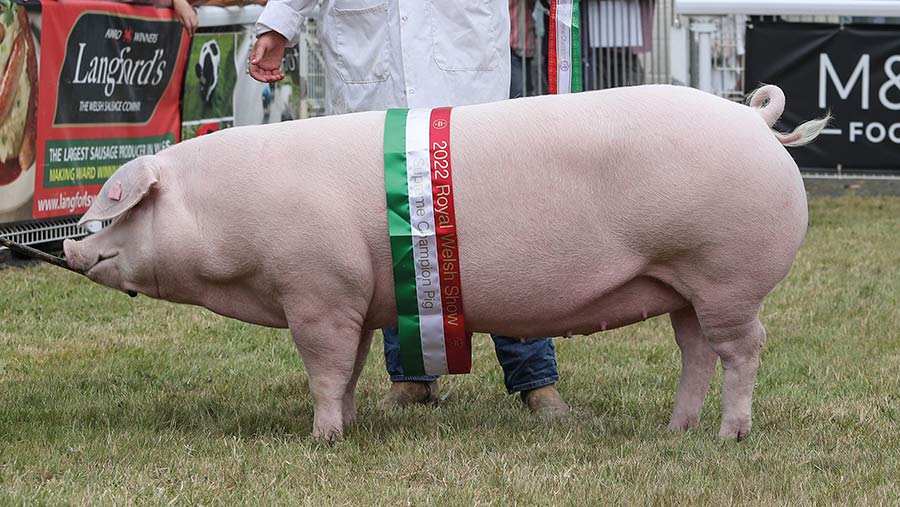Why showing is one rare breed producer’s top marketing tool
 Welsh Pig sow © 1st Class Images
Welsh Pig sow © 1st Class Images Within hours of Gussie Harmer’s Welsh pig scooping the supreme pig championship at the 2022 Royal Welsh Show, the young breeder had secured forward orders for four females from that gilt’s first litter.
“It was an example of how powerful and effective showing is as a marketing tool,” says Gussie’s mother, Susan. “Shows are fun and enjoyable from a social aspect, but they are also where we sell our breeding stock.”
Shows are often referred to as a shop window for pedigree sales – and for the Harmers, they are.
See also: Gene study could save rare pig breed
They run a herd of 22 Welsh pig sows on their 243ha (600-acre) family farm at Offham, near Lewes, Sussex, where they also produce beef from pedigree Sussex cattle and lamb from a pedigree flock of Southdown sheep.
Justin and Susan Harmer farm with their children, Lizzy Sargent, Edward and Gussie, who each have responsibility for one of the livestock types – Lizzy is the shepherd, Edward is in charge of the cattle, while Gussie oversees the pigs.
Welsh pig breed
The farming model is based on indigenous, heritage and rare breeds. “There is no Sussex pig, which is why we opted for the Welsh pig,” says Mrs Harmer.
Sales of breeding stock are generated through Offham Farm Pedigree Livestock, while meat from animals reared for slaughter is sold through the farm shop at Offham Farm.
A principal reason for selecting the Welsh pig over others is its meat-to-fat ratio. “Welsh pigs will perform on feed without any waste, and they have the perfect balance of fat and meat, even from a young age,” says Mrs Harmer.
“This isn’t true of some to other breeds we tried, which produced a lot of fat towards finishing.”
Interest in the Welsh pig – once an endangered breed – has increased again as farmers recognise its value in producing sows with high milk production and good mothering abilities.
The Harmers’ gilts are mated at eight months, to farrow no later than 12 months. They average 12 pigs born a head and 11 pigs weaned.
The sows produce two litters a year. Piglets are weaned at eight weeks, at an average of 15kg, and slaughtered at 24 weeks at 100kg.
Some of the breeding is done by eye and the rest by pedigree. That means if a sow has a weak point, this is compensated by using a boar that scores highly on that trait.
To boost numbers and safeguard important bloodlines for the future, the Harmers have recently bought Welsh pigs from some of the country’s top breeders.
“Because of the economic crisis in the pig industry, a lot of the bigger and very successful breeders of Welsh pigs have retired, so we have taken some of the better lines,” says Mrs Harmer. These include the Daffodil, Winchat, Model, Impish, Jean, Waitress, Marigold, Elenora and Sally families.
Show ring
The Harmers show their pigs, cattle and sheep at events across the UK.
Gussie not only won the supreme pig and breed champion at this year’s Royal Welsh Show with Offham Jean 2nd, but she also clinched the reserve breed champion with Offham Theresa 42nd.
The show ring is the family’s principal marketing tool, not just for pigs, but for sheep and cattle, too. “A few top animals going round the country winning everything will sell,” says Mrs Harmer.
“Take cattle, for example. One good bull winning shows over the summer will sell eight or more bulls for that breeder in the spring.”
These wins generate photo and media opportunities that can be used to raise the profile of their livestock via social media – spawning further sales.
“Whenever we win or get placed at a show we post it on Facebook – we always get a good response from that,” she says.
Performance recording
Those wins are the product of meticulous breeding.
There is no performance recording by the Welsh Pig Society so, for the Harmers, breed points are a priority when they are buying stock and breeding – and a pig must look like a Welsh pig with its distinctive pear-shaped body and lop ears that meet at the tips, just short of the nose.
They also look for a pig is that walks well, with sound legs and feet, and is well fleshed through the loin and hams.
Top tips for marketing rare breeds
Andrea Parry-Jones of the Rare Breeds Survival Trust (RBST) gives her top tips for marketing rare breed livestock
- Identify a unique selling point. This could typically be bloodline, appearance, showing success, gene carrier status, health status, longevity, fertility, reduced inputs, hardiness or ability to thrive in various habitats.
- Know your customer and how to reach them. Different characteristics are valued for showing, conservation or commercial operations. Rare breed shows and agricultural shows, breed society events, trade events, livestock markets, the RBST online marketplace and social media are all useful places to connect with customers.
- Only sell the best animals conforming to breed standard and type. Breed society pedigree registration is crucial. Key information for marketing typically includes prolificacy, temperament, productivity and achievements in showing, or surviving in harsh environments.
- Make sure your performance records clearly show strong points and benefits for the purchaser. Breed society software alongside your own records can help customers improve genetic diversity.
- Follow a good health and welfare plan, movement guidelines and Defra requirements.

